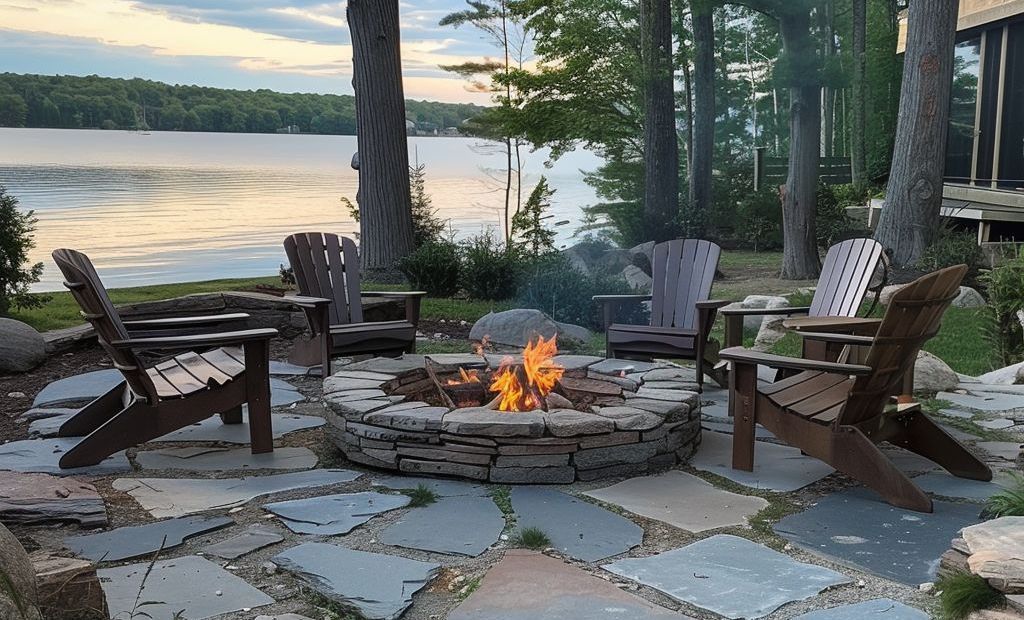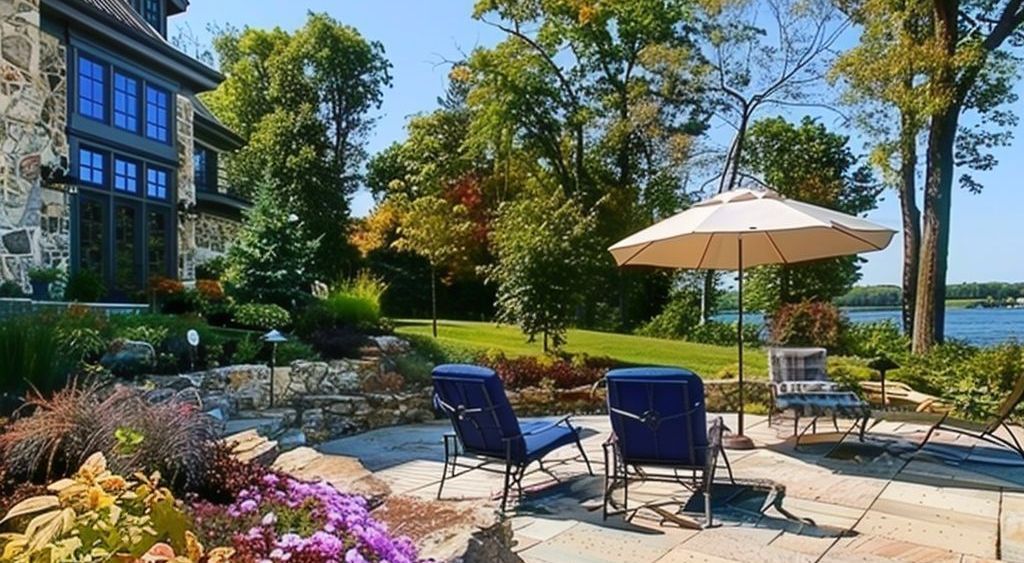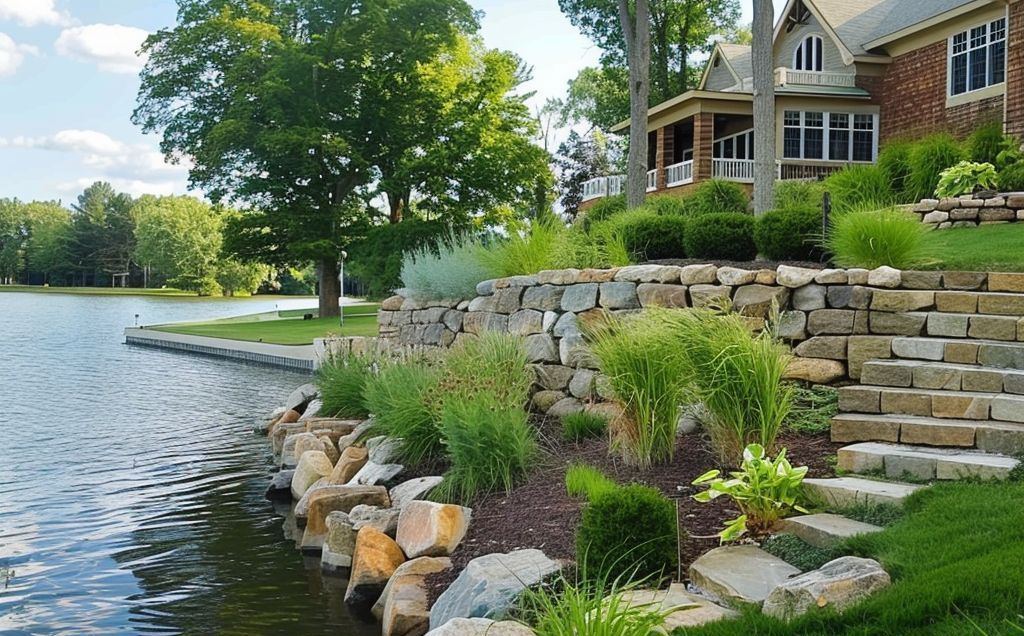Lakeside Retreat: Stunning Landscaping Ideas for Your Lake House
Owning a lake house offers an unparalleled opportunity to connect with nature, providing a serene escape from the bustling world. It's not just the architecture that draws one to this idyllic setting but also the potential for stunning lake house landscaping.
Adequately designed landscaping can transform a lakeside property into a harmonious retreat that blends with its natural surroundings. It goes beyond mere aesthetics; it extends the living space outdoors, enhances the property's value, and creates a tranquil environment that complements the water's edge.
Effective landscaping involves careful consideration of plant selections, terrain management, and creating spaces inviting relaxation and entertainment. By prioritizing a
lakeshore landscape design that integrates seamlessly with the lake's ecosystem, homeowners can ensure their lakeside retreat enriches their lives and resonates with the natural beauty of the setting.
Understanding Your Lakeside Environment
Understanding your lakeside environment marks the first step in unlocking the full potential of lake house landscaping. Each aspect, from soil and terrain to climate and local regulations, is pivotal in shaping a breathtaking outdoor space.
Analyzing Soil and Terrain
Soil quality directly influences plant health, dictating which species thrive. Lakeside properties often face unique terrain challenges, including sloping land and varying
soil types .
Homeowners must adapt their landscaping techniques to accommodate these conditions, ensuring stability and growth. For instance, terracing can prevent slope erosion, while selecting plants suited to your soil's pH and composition encourages a healthy, vibrant garden.
Climate Considerations for Lakeside Properties
Climate significantly affects lake house landscaping. It determines the plant palette that will flourish in your area. Knowing your climate zone allows for strategic plant selection, aiming for those that survive and thrive in local conditions.
Additionally, incorporating plants that naturally resist erosion can safeguard your waterfront property. Strategic planting reduces erosion risk and maintains the integrity of your lakeside retreat.
Zoning and Regulations
Navigating
zoning laws and environmental regulations is crucial for any landscaping project. Lakeside properties often come with specific restrictions to protect the ecosystem. Here are some tips for staying compliant:
- Research Local Regulations: Understand your area's specific guidelines on lakeside properties.
- Consult Professionals: Landscape designers familiar with local laws can offer invaluable guidance.
- Embrace Native Plants: Many regulations favor or require native species, benefitting local wildlife and reducing maintenance needs.
Design Principles for Lake House Landscaping

Thematic Gardens for Your Lake House
Choosing a cohesive theme for your garden establishes a sense of unity and character. For a rustic appeal, incorporate elements like natural stone and native plants. Modern designs benefit from sleek, geometric lines and minimalist plantings.If a naturalistic landscape calls you, aim for a wild, untamed look with native species and organic shapes . Your theme should reflect your style and the essence of lakeside living, creating a seamless transition between home and nature.
Creating Private and Shared Spaces
A thoughtful layout balances secluded retreats with welcoming areas for gathering. Design intimate nooks for solitude or reflection using plant screens or strategically placed structures.Meanwhile, open, inviting spaces with comfortable seating and fire pits encourage social interactions. Consider the flow between these areas to foster a sense of discovery and connectivity in your outdoor landscape.
Maximizing Views and Access to the Lake
Your lake house landscaping should highlight the property's star attraction: the lake view. Orient seating areas, paths, and windows to frame the most scenic vistas.Clear overgrown vegetation without disturbing the ecosystem, and choose low-growing plants that won't obstruct views. Pathways should add to the aesthetic and provide easy access to the water, ensuring the lake remains the focal point of your outdoor living experience.
Landscaping Ideas for your Lake House

Framed View & Extended Living
Create a layered planting scheme with low-growing shrubs, perennials, and ornamental grasses in the foreground. Taller flowering plants or small trees in the back will frame the breathtaking lake view.Complement this with a deck or patio, adding comfortable seating, a fire pit, or even an outdoor dining area to extend your living space and soak up the scenery.
Embrace Nature's Symphony
Nurture your local ecosystem by incorporating native plants that attract pollinators like butterflies and hummingbirds. Consider creating a natural swimming area with a rock beach for a lake-friendly and refreshing dip.Unwind under the stars with a fire pit or chimera, creating a warm and inviting gathering atmosphere.
Relaxation & Lakeside Leisure
String up hammocks between trees for a tranquil escape with a book or simply to relax and listen to the sounds of nature.Designate a meditation corner with comfortable seating or a yoga mat in a quiet spot to find inner peace. Incorporate fun for all ages with outdoor games like bocce ball, horseshoes, or a putting green.
Light Up Your Dreamscape
Hang string lights to create a magical ambiance in the evenings, wrapping them around trees, draping them over a pergola, or lining a pathway. Solar path lights add safety and charm to walkways and patios after dark.Strategically placed spotlights can highlight key features of your landscape, like beautiful trees or water features, for a touch of drama.
A Walk on the Wild Side
Create a winding walking path that leads to the water's edge, allowing you to explore the natural beauty of your lakeside property and enjoy the scenery from different perspectives.This path can be lined with native wildflowers, ornamental grasses, or even miniature shrubs for added visual interest.
Seasonal Landscaping Tips for Year-Round Beauty

Adding a vibrant layer to your lakeside retreat involves designing with the present in mind and planning for the changing seasons. This ensures your outdoor space adapts and thrives throughout the year, offering a dynamic backdrop to your lake house, regardless of the season.
Spring Awakening
As the snow melts and the first signs of green emerge, it's time to breathe life back into your garden. Begin with a thorough cleanup, removing debris and cutting back dead plant material.
Early spring is ideal for planting hardy perennials and starting seeds indoors. Assess your landscape for winter damage and plan for repairs. Incorporating flowering bulbs planted in the fall will reward you with bursts of color.
Summer Vibrance
With the arrival of warmth, your focus shifts to maintenance and enjoyment. Regular watering becomes crucial, especially in periods of drought. Mulching helps retain soil moisture and keeps roots cool.
Autumn Transition
Fall's cooler air and moist soil create ideal conditions for planting trees, shrubs, and perennials. It's also the time to divide crowded plants. Preparing your garden for winter is crucial—mulch tender perennials, rake leaves, and consider late-season lawn fertilization to promote root growth.
Winter Prep
Protect your landscape from the cold by winterizing irrigation systems, wrapping vulnerable trees and shrubs, and applying a protective layer of mulch.
Design Your Dream Lakeside Retreat
Lake house landscaping allows you to blend functionality with personal style, transforming your property into a testament to thoughtful design and harmony with nature. It's not just about aesthetics; it's about creating a sanctuary for relaxation and socialization.
With the insights and strategies outlined, you can turn your lakeside property into the retreat of your dreams. Let creativity guide you, and witness your lakeside haven come to life, providing endless enjoyment and tranquility.










